Creating homemade pasta and noodles might be an enjoyable cooking voyage overflowing with different flavors and feel in your kitchen. Whether you are a professional chef or a cook at home trying to reproduce the dishes you love, you must choose the correct machine for making pasta and noodles if perfecting your noodles is something you want every single time. This article will look at what one needs to know when buying such machines; different types available on the market today along with their features as well as merits attached to each type so that through this guide we can give comprehensive knowledge which should help people make decisions based on facts not fiction about purchasing pasta noodle maker machines. We also hope our suggestions will enlighten you more about them while easing up things during your next shopping spree, ensuring all these aspects enhance creativity in cooking and simplifying the process of making spaghetti at home.
How Does a Pasta Maker Machine Work?
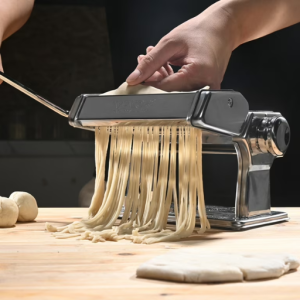
Image source: https://www.walmart.com/
A pasta machine is a device that can turn dough into different kinds and sizes of pasta by extruding or rolling and cutting it in various ways. To begin with, dough is made by mixing flour with water, sometimes adding eggs or oil for different textures and flavors. In manual pasta machines, the dough is rolled out into thin sheets by passing them through rollers, which are then cut into desired shapes. In automatic ones, electric motors do all these operations instead; they push the dough through extrusion dies to form spaghetti, fettuccine penne, etcetera while exerting equal pressure on them to get uniform noodles each time during cutting.
How Do You Use an Electric Pasta Maker?
Using an electric pasta maker is very simple and involves some easy steps. Firstly, mix flour, eggs, and water until it becomes firm yet flexible. After that, divide the dough into smaller pieces to make it easier to work with. Then, attach the necessary shaping die onto the machine, which will depend on what kind of pasta you want to make. Turn on your device and put dough portions into its hopper. The machine will knead and extrude dough through a die, creating perfectly shaped pasta. Cut those extruded pasta at the desired length and allow them to dry a little before cooking them. Always consult the manufacturer’s instructions for better outcomes specific to your model.
What Are the Parts of a Pasta Machine?
Usually, a pasta machine has different parts that combine to convert the dough into the final product. They are as follows:
- Rollers: These cylinders smash the dough, creating flat and thin sheets. The thickness of these sheets can be adjusted because they have different levels.
- Cutting Blades: Cut pieces from rolled dough sheets into various shapes and sizes, like fettuccine or spaghetti.
- Hopper: It is located at the top where you put a portion of your dough before it moves towards either rollers or extruding dies through it.
- Extruding Dies: There are many interchangeable plates, each producing its pasta shape; for example, this plate can make round shapes such as spaghetti, while another type of plate can also produce tube-shaped pasta like penne.
- Crank/Handle: This is used in manual machines and operated by hand to turn round bars called ‘rollers.’ In electric models, an internal motor does this automatically once switched on.
- Adjustment Knob/Dial: Allows user control over how thick sheets come out by adjusting space between two roller pairs’ axes, i.e., the distance between them determines the final sheet’s thickness level;
- Pasta Cutter: Some models may feature this additional tool or built-in part, which cuts off extruded pieces into required lengths.
These elements enable an efficient production process of making different kinds of pasta consistently well.
What Are the Benefits of Using a Noodle Maker?
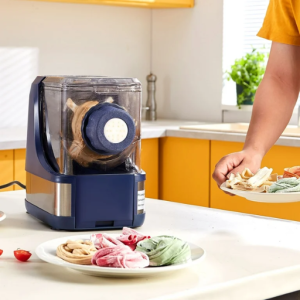
The noodle maker is handy in various ways, making homemade pasta better and more enjoyable. First of all, it allows you to manage what is included in the dish to have healthier noodles without preservatives. Secondly, by changing the thickness of the dough and the shape of the noodles, one can cook different types of pasta suitable for various meals. Besides saving time and energy compared with rolling out each sheet by hand and then cutting them into ribbons or squares, this machine does everything at once, thus making work faster and less laborious. In conclusion, another reason people love making their spaghetti is that it tastes better than any other kinds available in the market; it looks good and feels great when chewed on.
Why Choose a Homemade Pasta?
There are many benefits to homemade pasta compared to store-bought options. Above all else, it is the freshest way you could ever have it because each bite tastes like heaven. Secondly, by making pasta from scratch, one can manage what goes into it and avoid chemicals used as preservatives or artificial enhancers. Another point is that recipes can be altered according to dietary requirements, i.e., gluten-free or whole wheat flour. Finally, yet importantly, this process provides an opportunity for creativity by trying out different shapes and flavors and serves as an enjoyable culinary adventure.
How Does a Pasta Press Save Time?
A pasta press is a machine that automates the rolling and cutting parts of making homemade pasta, thus saving much time. Unlike manual methods, which require a lot of physical work and take long to achieve even thickness or shape, this device can quickly produce uniform results every time. Moreover, it is easy enough for anyone to operate, so you do not need to spend too much on preparations or cleaning up afterward – just make lots of yummy fresh pasta while having fun.
Manual vs. Electric: Which Noodle Maker Machine Is Right for You?
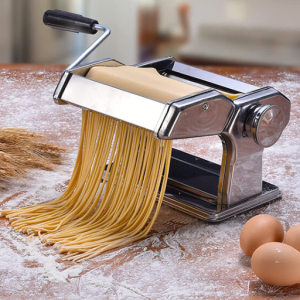
Choosing an electric and manual noodle-making machine hinges on personal needs and wants. Typically, manual machines are cheaper than their counterparts, giving the user more power over the thickness and consistency of noodles. Such devices are perfect for individuals who love making pasta by hand and can find enough time. Conversely, electric ones save time and effort; hence, they are ideal for busy people or those who need large quantities quickly. Most electric models automate some steps, thus reducing the physical input required during operation and saving time. Therefore, if you value tradition or hands-on experience with touchy-feely satisfaction, then go for a manual machine, while if being pragmatic about convenience coupled with speed ranks higher on your list, then an electrical model will suit you better.
Comparing a Manual Pasta Maker to an Electric Pasta Maker
There are definite advantages to both a manual and an electric pasta machine.
The simplicity and affordability of manual pasta makers are praised. These machines make it easy to control the thickness and texture of the dough, which is perfect for traditionalists who love getting their hands dirty when making pasta. They are also generally less complex, with fewer parts that could potentially break or need repairing, so they tend to be easier to clean and maintain.
On the other hand, electric pasta makers can boast of being very convenient and efficient in what they do best. These devices can automate rolling, kneading, and cutting, significantly reducing prep time and required physical labor. If you make pasta often or if there is a need for quick production in large quantities, then this is definitely the way forward. Electric models come with different settings and attachments, so there’s more variety in terms of what kind of pasta they can produce.
In conclusion, if cost-effectiveness coupled with hands-on involvement appeals more than anything else, I would recommend manual over electric pasta makers for your consideration; otherwise, convenience and speediness, together with high volumes produced, should dictate buying an automatic maker instead.
Using a Handheld Noodle Maker
A simple and fun method for making fresh pasta at home is using a handheld noodle maker. First, you need to prepare your dough following the recipe you have chosen, ensuring that it has the right consistency. Then, divide the dough into smaller portions that you can easily handle and flatten them slightly by hand or with a rolling pin.
Afterward, put the dough into your handheld noodle maker and turn its crank (or trigger, depending on its model). The machine will extrude noodles of different shapes or thicknesses per your requirements. Make certain that during the extrusion process, the dough is sprinkled with flour so it doesn’t stick together. Once they come out from the machine, lay these ribbons on any drying rack or floured surface – this will keep them from sticking together while drying.
Once you’ve made your noodles, they can be boiled immediately in salted water or left to dry for future use. These gadgets are designed especially for people who like doing things themselves and want to try out various sizes and forms of pasta strands. Cleaning should not pose much difficulty unless indicated otherwise by the producer; therefore, always read the instruction manual carefully before cleaning any kitchen appliance such as this one. It may take some time, but with practice, even an amateur cook can produce excellent homemade spaghetti thanks to his portable pasta-making factory.
Features to Look for in the Best Electric Pasta Makers
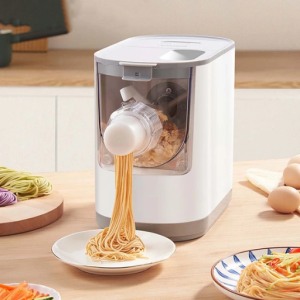
When choosing the finest electric pasta maker, there are certain vital factors to take into consideration:
- Simplicity of Use: Pick a model with straightforward controls and clear instructions for making pasta easier.
- Power/Speed: Choose a machine that operates fast and is powered by solid motors to ensure quick and effective pasta production.
- Flexibility: You should select a pasta maker with various attachments and settings so that you can achieve different shapes and sizes when making pasta.
- Sturdiness: The machine should be made from high-quality materials, which makes it durable even after being used for long periods without requiring any maintenance services.
- Cleaning: If possible, go for models with parts that can easily be disassembled or cleaned in dishwashers.
-
Capacity: Depending on the quantity of dough you will be working with regularly, ensure your choice has enough capability to handle such amounts.
Benefits of a Machine with 7 Molds
A pasta maker with seven molds has several advantages:
- Variety: There are seven different molds, meaning you can make many different shapes and sizes of pasta. This allows for experimentation with new recipes and catering to various culinary preferences.
- Convenience: Multiple molds on the same machine make it easier to make pasta. You do not need to buy or store separate attachments.
- Efficiency: Switching between different pasta shapes is seamless; diverse kinds can be made within one session without wasting time.
- Customization: With such a variety of molds available, it is now possible to customize your dishes more than ever before by tailoring them to specific tastes or dietary requirements.
- Versatility: Machines with multiple molds can be used for everything from traditional Italian pasta to ground-breaking homemade ones, greatly expanding what you can cook at home.
- Cost-effective: Getting one unit fitted with numerous molds might save more money than purchasing individual gadgets; this also helps conserve kitchen space since they take up less room than side-by-side.
-
Enhanced Creativity: The broader range of shapes and sizes impels creativity as people try out new forms and textures, transforming ordinary meals into gourmet experiences.
What Does a Pasta Roller Do?
A pasta roller is a device in the kitchen meant to press and form pasta dough into thin, uniform, flat sheets. This guarantees equal depth and smoothness by feeding the dough amid its rollers. It is necessary to make lasagna, fettuccine, or ravioli, where different kinds of pasta should have even thickness. The adjustment settings can control how thick the dough becomes, making this tool adaptable for various recipes. In addition, it saves one time since with a pasta roller, you do not have to make them by hand like traditional artisans did, which also requires more effort on your part if compared side by side with this machine.
Top Recommendations for the Best Pasta Makers of 2024
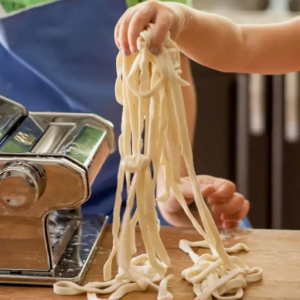
1. Marcato Atlas 150
When people need a pasta maker that lasts and can do many things, they choose the Marcato Atlas 150. It is made of solid materials, with adjustable rollers of various thickness levels and different cutting attachments to make any pasta shape possible.
2. Philips Pasta Maker
The best thing about the Philips Pasta Maker is its ease of use. Everything is automated. All you have to do is put in the ingredients and select a program, and it will mix, knead, and extrude pasta for you within minutes. Plus, multiple shaping discs are included so that you can create your favorite types of pasta without any hassle.
3. KitchenAid Pasta Attachments
The KitchenAid Pasta Attachments are perfect for those who already own a stand mixer by this brand. Attaching them is simple, and they come with a roller/cutter that makes spaghetti, fettuccine, and lasagna sheets, among other things; all powered by the strong motor of your KitchenAid stand mixer itself, so it saves effort as well as time while making delicious homemade noodles quickly!
4. Imperia Pasta Maker
If you want an authentic Italian-style machine, then go with the Imperia Pasta Maker, which has been known for its traditional design and durability, thanks to its strong build quality, too! You can adjust settings accordingly according to the required thickness of dough or choose between either one smooth roller or rough-textured surface rollers, depending upon what kind of pasta shapes you prefer.
5. CucinaPro Pasta Maker Deluxe Set
The CucinaPro Pasta Maker Deluxe Set has a wooden drying rack and several blades so beginners won’t need anything other than this kit alone! The hand-cranked machine allows novices like me who have little experience making pasta at home to quickly achieve great results, mainly because the comprehensive accessories provided make everything so intuitive to use. And if you’re an experienced pasta maker already, then fear not either since this set offers you many more options, too.
Each pasta maker offers unique features and benefits, catering to diverse cooking needs and preferences. Whether you prioritize automation, versatility, or traditional methods, a pasta maker is on this list to suit every kitchen.
Review of the Philips 7000 Series Pasta Maker
The Philips 7000 Series Pasta Maker stands out in its convenience and performance. This machine does all the work for you—it even has a built-in motor! With this powerful device, you can make fresh pasta in less than ten minutes after you push start on the user-friendly interface. Many types are available as well since multiple shapes are possible with different discs included. The exactness of each shape is ensured every time due to an extrusion technology that always gives consistent results.
There’s nothing simple about the mixing, kneading, and extruding system built into this robust machine. It was designed for efficiency so amateur and professional chefs could use it efficiently. Dishwashing these parts should be easy, too, because they’re all removable and safe inside dishwashers, unlike other models. It seems like nobody can find anything wrong with how basic it is, either, since most reviewers liked how fast they could start making their custom pasta at home with such little effort, thanks again to its simplicity.
Is the Hamilton Beach Electric Pasta Maker Worth It?
According to reviewers, the Hamilton Beach Electric Pasta Maker is an affordable and easy-to-use machine. This automatic device simplifies pasta-making by mixing, kneading, and extruding the dough. It can make different pasta shapes and has a setting that lets you choose how thick or thin you want your noodles to be, which is great because it has versatility with recipes! People love this product because it has a user-friendly interface, and everything on here is super easy to clean – perfect for anyone who values convenience when cooking at home. Although more advanced models might come with extra features, considering their performance, simplicity, and budget-friendliness, it’s worth every penny if one wants tasty, fresh, homemade pasta without too much strain on one’s wallet.
An Overview of the Atlas 150 Pasta Machine
The handcrafted Italian Atlas 150 Pasta Machine by Marcato is known for being sturdy and efficient. It is created with the highest quality chrome-plated steel, ensuring its long life and adding to its premium feel. This machine has different rollers that can be adjusted to ten widths, enabling users to make pasta like lasagna, fettuccine, or tagliolini. The Atlas 150 requires manual work, unlike electric models, which, according to many users, allows for more control over the dough-making process. Because of its timeless design and reliable performance, this appliance has become popular among beginners and professionals. Maintaining cleanliness in such a device as this does not pose any difficulties: you just need to take off some parts. Hence, everything becomes easily accessible while cleaning – no wonder people say simplicity is genius.
Common Problems and Solutions with Noodle Pasta Making Machines
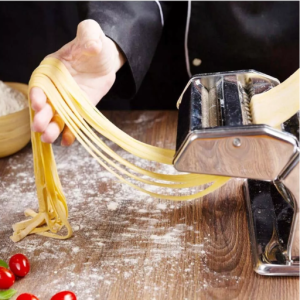
The problem with most noodle pasta machines is that the dough sticks to the rollers or cutters. This can be fixed easily by making sure that the dough is the right consistency—firm but not too wet. Dusting some flour on your dough also prevents it from sticking. Another common issue is uneven noodles’ thickness; this occurs when one fails to set up their machine correctly or rolls out an imperfectly even sheet.
The manual crank may be challenging to turn, especially when working with denser types of dough like those used for making soba noodles. In such cases, try dividing your dough into smaller portions to make it manageable, thus making it easy to crank. Last but not least, if you don’t clean up well after every use, bits and pieces will harden along different parts, leading to blockage of some areas, hence jamming. Thus, all removable components should be cleaned regularly and thoroughly if one wants smooth running. By following these suggestions, your pasta-making process will become more efficient and enjoyable.
How to Fix Dough in a Pasta and Noodle Maker
Ensuring the dough consistency is correct is essential to guarantee a smooth pasta-making process. When the dough is sticky, add some flour in small quantities, one spoon after another, while kneading until it holds shape without sticking to your fingers. Conversely, if it’s too dry and crumbly, mix it with water or an already-beaten egg to achieve a softer texture.
When the dough turns out tough and resistant, it might require more kneading. Cover and let rest for about 20-30 minutes, which relaxes the gluten, making it easier to work with. Always check if the dough is well-floured before sticking it in the machine; also consider re-kneading and re-rolling through the thickest setting before moving onto thinner settings so as not to jam or tear anything.
Patting the dough down into a flat disk before feeding it through the machine and gradually reducing the width of the settings can ensure that the thickness of the dough is uniform. Proper handling and dough consistency are vital for the trouble-free operation of your pasta maker.
Maintaining Your Electric Noodle Maker
It is essential to perform regular maintenance on your electric pasta maker to ensure it continues to work well. First, unplug the appliance and remove any detachable parts as per the manufacturer’s instructions. Clean each piece thoroughly with warm, soapy water, using a soft brush if necessary to remove any dough or flour residue. Don’t immerse the main body in water; wipe it clean with a damp cloth. Apply some food-grade lubricant on moving components for smoothness during operation after cleaning and reassembling everything back together before storing it in a dry area without moisture, which may cause damage over time. Look at it regularly and handle it carefully – this will not only help extend its life span but also make pasta-making more enjoyable as well as efficient.
Troubleshooting Issues with a Pasta Maker Machine
To troubleshoot problems with a pasta maker, make sure the dough has proper consistency, which should be a little bit sticky but not too tacky; if it sticks on the wall, add some flour. Put a few drops of water on them for crumbly or falling apart doughs until they hold together. If the machine does not cut pasta correctly, check for any dough buildup around the cutting blades and clean them well so they may slice through noodles quickly again. Also, ensure enough lubrication for your machine plus correct roller thickness settings because incorrect ones can cause this problem, too. When the motor stops or works hard, don’t overload it by putting too much dough once, and recheck the alignment and functionality of each part because all these could lead to such issues. Regular cleaning and appropriate handling of dough are vital in fixing common problems experienced by pasta makers.
Frequently Asked Questions (FAQs)
Q: What should I look for when choosing a pasta and noodle maker machine?
A: When choosing a pasta and noodle maker machine, consider factors such as the type of pasta you want to make (e.g., spaghetti, lasagna, or fettuccine), the machine’s ease of use and cleaning, whether it offers adjustable thickness settings, and if it is manual or electric. You might also want to look for automatic mixing and kneading features to save time.
Q: Is a Kitchenaid pasta press attachment worth the investment?
A: A Kitchenaid pasta press attachment can be worth the investment if you already own a Kitchenaid mixer and frequently make pasta. It simplifies making various pasta shapes and can be more convenient than a standalone pasta maker machine noodle.
Q: How does an automatic pasta maker differ from a manual one?
A: An automatic pasta maker typically mixes the dough, kneads it, and extrudes it into pasta shapes, requiring minimal effort. Manual pasta machines, on the other hand, require you to mix and knead the dough by hand and then use a hand crank to roll and cut the pasta.
Q: Can I make fresh pasta at home without a noodle machine?
A: You can make fresh pasta at home without a noodle machine, but it will require more effort. You must mix and knead the dough by hand, roll it out with a rolling pin, and manually cut it into the desired shapes.
Q: What are the benefits of an electric pasta machine?
A: An electric pasta machine can save you time and effort by automating mixing, kneading, and extruding the dough. It often comes with additional features like adjustable thickness settings, and some models even include multiple attachments for different pasta shapes.
Q: What kinds of pasta shapes can I make with a noodle maker machine with seven molds for spaghetti?
A: A noodle maker machine with seven molds for spaghetti can usually produce a variety of pasta shapes, including spaghetti, fettuccine, penne, lasagna sheets, and more. The specific shapes available will depend on the machine and the manufacturer’s design.
Q: How do I clean a stainless steel pasta maker?
A: First, disassemble any removable parts to clean a stainless steel pasta maker. Wipe down the components with a dry cloth and use a soft brush to remove any dried dough. Avoid using water or soap on the parts, as moisture can cause rust and damage the machine.
Q: Are adjustable thickness settings necessary in a pasta maker?
A: Yes, adjustable thickness settings are essential as they allow you to customize the thickness of your pasta. Different pasta shapes require different thicknesses, so having this feature ensures you can produce various pasta and noodle types.
Q: What features should I consider if I have limited kitchen space?
A: If you have limited kitchen space, look for a compact pasta and noodle maker. A machine with built-in storage for attachments and easy disassembly for convenient storage can be precious. Additionally, consider the machine’s footprint to ensure it fits in your available space.
Q: How do noodle rollers and cutter attachments work?
A: A noodle roller and cutter attachment typically works by flattening the pasta dough to your desired thickness and then cutting it into specific pasta shapes. It can be manually operated using a hand crank or powered by an electric attachment.















